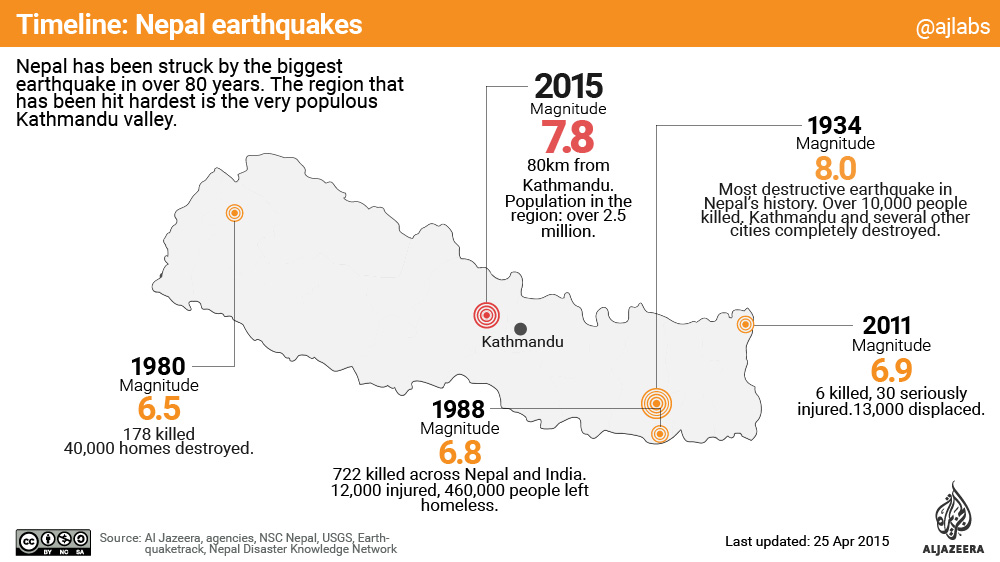More aftershocks in Nepal as death toll soars
Aid agencies prepare “massive” operations in quake-hit Nepal as death toll rises to at least 4,000.

Nepal has been rocked by aftershocks as the death toll from the magnitude 7.8 quake rose to at least 4,000, as aid agencies prepared “massive” humanitarian operations.
Nepal police said on their Facebook page late on Monday evening that over 3,904 deaths had been counted so far, and 7,180 more were reported injured.
In addition, an avalanche caused by the earthquake killed 18 people at Mount Everest’s base camp, 61 people were killed in neighbouring India, and China reported 25 people died in Tibet.
|
|
Al Jazeera’s Andrew Simmons, who is reporting from Bhaktapur, said that more people were feared dead in the ancient city, and residents were struggling to dig through the rubble with limited help from the government.
He also reported sporadic fighting among residents of Bhaktapur over supplies of food, water, and tents.
Al Jazeera’s Sohail Rahman, who is reporting from the capital Kathmandu, also said that “the death toll is expected to rise in the coming hours and days”, as rescuers try to reach remote villages that have been inaccessible since the quake hit.
“Many thousands have been left homeless, and people are sleeping out in the open, and it’s chilly when the sun sets across the country,” he said.
Meanwhile, rescue efforts have intensified in Nepal amid a stream of foreign aid reaching the capital Kathmandu.
The United Nations said it would release $15m from its central emergency response fund.
The first nations to respond were Nepal’s neighbours – India, China, and Pakistan, all of which have been jockeying for influence over the landlocked nation.
Nepal remains closest to India, with which it shares deep political, cultural and religious ties.
Aid experts said disruptions at the airport were likely to continue, slowing the arrival and distribution of vitally needed supplies.
Kipp Branch, senior medical supply officer for the MAP International charity, said the group was putting together an extensive medical supply shipment that would only be sent once it had clearance to land and distribute emergency health supplies intended to support 10,000 people for three months.

Military cargo planes from India and Pakistan have landed at Kathmandu airport, which has been struggling to handle the volume of cargo and civilian planes flying in.
“Kathmandu has a very small airport, therefore they are making a priority that military aircraft with rescue personnel are allowed first. Also they are trying to get in NGOs,” Al Jazeera’s Rahman said.
“India and Pakistan are coming to the forefront, as they have a lot of experience in this sort of catastrophe.
“I saw military aircraft from China, Japan as well as Sri Lanka.”
Base camp avalanche
The magnitude 7.8 quake also touched off an avalanche at the base camp of Mount Everest in which at least 17 people were killed.
|
|
Scores of people are still stuck in the mountains and a rescue operation is under way to lift them from the frozen frontiers.
Other countries involved in aid efforts are UAE, Israel, the US and members of the European Union.
They have sent or pledged money or supplies – including medicines, a mobile hospital and rescue teams.
Al Jazeera’s Rahman said a senior Dutch diplomat was part of a combined EU aid effort, “organising and trying to sort out a large contingent of Dutch rescue and recovery personnel”.
Ek Narayan Aryal, Kathmandu district chief administrator, said tents and water were being handed out on Monday at 10 locations in the capital, but that aftershocks were leaving everyone jittery.
The largest, on Sunday, was magnitude 6.7. Four large aftershocks were felt overnight and into Monday morning.
“There have been nearly 100 earthquakes and aftershocks, which is making rescue work difficult. Even the rescuers are scared and running because of them,” Aryal told AP news agency.
Shortage of food and water
In Kathmandu, tens of thousands of people spent the night sleeping in parks or on a golf course.
Kathmandu's heritage buildings are almost completely lost
“We don’t feel safe at all. There have been so many aftershocks. It doesn’t stop,” said Rajendra Dhungana, 34, who spent Sunday with his niece’s family for her cremation at the Pashuputi Nath Temple.
Aid workers have warned that the situation could be far worse near the epicentre.
The US Geological Survey said the quake was centred near Lamjung, a district about 80km northwest of Kathmandu. While not far away, poor roads and steep mountains have made Lamjung difficult to reach.
Overwhelmed authorities were trying to cope with a shortage of drinking water and food, as well as the threat of disease. There were reports of water and vegetables being sold at inflated prices.
The sick and wounded were lying out in the open in Kathmandu, unable to find beds in the devastated city’s hospitals. Surgeons set up an operating theatre inside a tent on the grounds of Kathmandu Medical College.
“We are overwhelmed with rescue and assistance requests from all across the country,” said Deepak Panda, a member of the country’s disaster management.
Most shops in Kathmandu, where more than 1,000 people have died, were closed after the government declared a weeklong period of recovery.
Anurag Acharya, a Kathmandu-based journalist, said that “people are furious and not allowing journalists in the devastated area [Durbar Square]”.
“Kathmandu’s heritage buildings are almost completely lost,” he told Al Jazeera.
![Overwhelmed authorities in Nepal are trying to cope with a shortage of drinking water and food [Reuters]](/wp-content/uploads/2015/04/52f174e0c25f46f8b097c20122817e7a_18.jpeg)